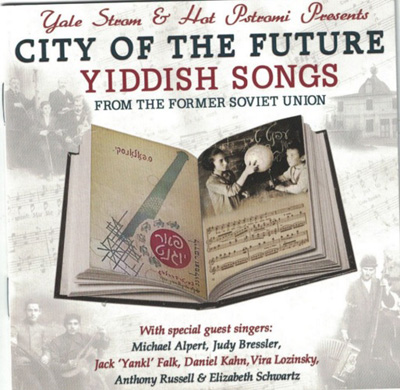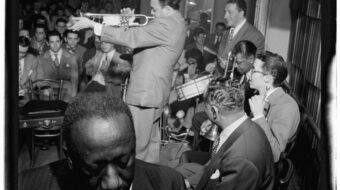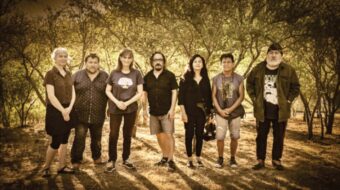
Eric: So, your CD City of the Future has just been issued by ARC Music Productions International Ltd. out of England. How does it feel?
Gordon: It’s exhilarating. It’s been a long time coming and I’m very proud of our work on it. It’s been a highly collective process between me as executive producer (people in the film biz will recognize that as the guy who raised the money) and the artists, headed up by the world-renowned, multi-talented Yale Strom.
Eric: “New” Soviet Yiddish songs? What does that mean?
Gordon: A little background is necessary. One of my jobs as director of the Southern California District of the Arbeter Ring (Workmen’s Circle) was to gather, sort and ship out thousands of books donated locally to the Yiddish Book Center in Amherst, Mass. We saw hundreds of volumes of the Collected Works of Sholem Aleichem, and quite a few of the Collected Works by Guy de Maupassant in Yiddish(!). But occasionally some unique ephemera would turn up. Around 1998 there appeared in a shopping bag left outside our door, a copy of Samuil Polonski’s “Far yugnt/For Youth,” a songbook of 19 numbers published in the USSR in 1931, with lyrics by some of the most important Yiddish poets active in Soviet Russia.One day, I said to myself, setting it aside, I’m going to take a closer look at this and see if we can do something with it.
Eric: And?
Gordon: We had to get the right personnel in place at Arbeter Ring to assess what this book reallywas. I can read Yiddish, so I understood that this collection was created to form the basis of a new Soviet Jewish repertoire for use in the Yiddish school system. In 1931 there were Yiddish schools, theaters, choruses, and the so-called “autonomous Jewish republic” of Birobidzhan in the Far East had just been established. We had a gifted musical director of our in-house Mit Gezang Yiddish Chorus, Kathryn Rowe, who faithfully entered all these songs with their original vocal and piano parts into a musical computer program. We had a expert translator in Hershl Hartman, and I did the modern transliteration so that our singers could read the texts.
Every August, Arbeter Ring cosponsored a program of talks and music to commemorate the 1952 murder of a dozen or so leading figures in Soviet Yiddish culture, including, tragically, poets Itsik Fefer, Perets Markish and others whose lyrics Polonski used. Finally, on August 10, 2008. we presented in cantata form, in the order they appeared in the book, all 19 songs in concert, with piano accompaniment as published. This was a world premiere performance, because I’m sure that no one in the USSR ever staged the songbook in that format.We had an appreciative audience (although one or two critics thought we interpreted these songs about building socialism with a little too much enthusiasm!). That audience, and another larger one a year later in Tucson, were for all practical purposes the only people who hadever heard these songs in this country.
Eric: Were they really all new to Western ears?
Gordon: Only two or three of these songs at most ever escaped the pages of the songbook into the known Yiddish repertoire, “A krenetse/A Well” and “Fabrik lid/Factory Song.” The opening song of the collection, “Hirsh Lekert,” an already extant folksong, appearedas if to say, “This is the history we came out of.”There’s one other song whose moving lyric by Fefer had been set by another composer, but so far as I know “Ver hot es?/Who Did It?” in Polonski’s version is a premiere recording along with all the other songs.
Eric: What are these songs about?
Gordon: Actually they’re not all political. “A krenetse,” for example, is a pastoral ode to the young women and men who gather at the well. There’s another song about sledding in wintertime, and a sweet, poignant memory of childhood in pre-revolutionary times. But most are about building new cities (“City of the Future” is one title), life on the collective farm, the Red Army defending the Soviet Union, the day the news of Lenin’s death came to town, and a particularly amusing one about a “meydl” – a young woman – allowed to drive a tractor. That one is the most “Jewish”-sounding item.
It gives me a chill to imagine 10-year-old boys in Soviet Yiddish schools singing the song “Royte Armey/Red Army” with Itsik Fefer’s lyricsin 1931. Ten years later they would be young men of twenty and heading for the front to help repel the Nazi invaders. I know it’s hyperbole to say this, but I can’t resist making the claim that this song – along with similar ones in other Soviet songbooks in other languages – saved the world from fascism! We can never forget that as many as 25 million Soviet citizens lost their lives in the defense of the motherland.
Eric: No fulsome praises for our Great Leader Joseph Stalin?
Gordon: Not at all. His name is never mentioned either in the songs or in the foreword. In 1931, the purges of the mid-1930s were still unforeseeable, not to mention Nazism, a new World War and the Holocaust, nor of course the postwar crackdown on Jewish culture. The 1931 songbook totally predates the Stalin cult of personality.
Eric: 1931. That was the time of the Great Depression.
Gordon: Yes, and worth remembering that. While the rest of the world languished in profound economic despair, the USSR with its planned economy was building and growing, and even importing skilled workers. At that particular moment in the arc of Russian, Soviet, and world history, our 29-year-old composer and his lyricists had plenty of reason to be hopeful.
Eric: So who was Polonski?
Gordon: He was not in a league with Shostakovich or Prokofiev, to be sure. But Samuil Vladimirovich Polonski (we call him Shmuel) was central to Soviet Jewish music, and yes, there indeed was some. There’s a biographical entry on him in the Encyclopedia of Soviet Composers and Musicians (Moscow, 1981). Born in 1902 in Gaisino in the Podolsk region of Ukraine, he grew up in a traditional Jewish environment, the son of a klezmer violinist father and a mother who knew and sang a treasury of folk songs. Shmuel himself became a master of improvisation on woodwind instruments and played in an itinerant klezmer orchestra.
But the world was changing fast: He was 15 years old in 1917 when the Russian Revolution broke out. From 17 to 20, he served in the Red Army, and by his early 20s was already leading musical ensembles and choruses.It’s worth noting that Polonski died at the age of 52 in 1955 – two years after Stalin – so we presume that he was left personally unscathed by the anti-Jewish terror of the late 1940s and early 1950s. But there is scant reference to him after his move to Moscow in 1945, when he returned from the eastward evacuation that saved millions of Soviet Jews, and Jews from elsewhere in Europe as well.
Eric: How are we supposed to hear these songs today?
Gordon: Polonski occupied the space allowed for and created by Soviet Jewish musicians in a world that had, to say the least, its uncertainties. In 1931 Polonski could have guessed that with growing urbanization, industrialization and assimilation, the future of Yiddish in the Soviet Union might not be extremely bright. Those same larger historical forces operated everywhere, not only in the USSR, of course. The Yiddish schools were not attracting a large number of Jewish children, nor would Birobidzhan ever draw a significant population of Jews. Most parents wanted their children in Russian-language schools in the larger cities to ease their integration into modern society.
So I wonder if, while writing these songs in utter sincerity, he was not also conscious of creating a record of a specific uplifting moment in time, a time of progress, building, pride, and hope, and as a legacy to the future. In a very real sense, that quality of being an artifact of its period became more real as the terrible tragedies of the later 1930s, 1940s and 1950s unfolded. Polonski wrote these songs for the future, for us to discover and cherish. These songs also preserve some very precious lyrics that likely don’t turn up anywhere else in their authors’ published works.
Eric: So is the album more or less an academic restoration of the piano-vocal score?
Gordon: To the contrary! I approached Yale Strom to make new arrangements of these songs because I knew that a whole CD of piano and voices might sound quaint or archaic. So Yale put his genius to work and re-imagined these songs with today’s version of all the hope and joy and thrill of building a new future, which, by the way, the world needs doing in so many ways! There’s a wide range of instrumentation – in fact, no piano at all – and definitely a salute to Polonski’s own klezmer background. Best of all, we have the highly accomplished musicians that Yale works with and the most prominent names in Yiddish music all gathered together to bring these songs to life: Michael Alpert, Judy Bressler, Elizabeth Schwartz, Daniel Kahn, Jack “Yankl” Falk, Vira Lozinski, and Anthony Russell. I admit it, I have visions of a Grammy in my future! So, enjoy!












Comments